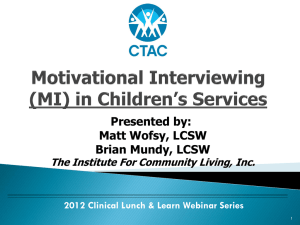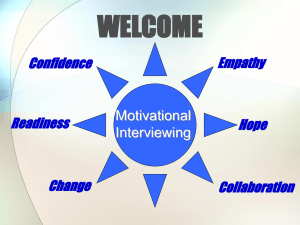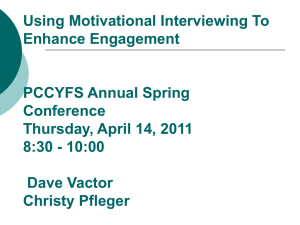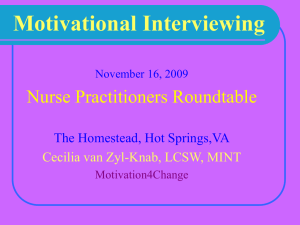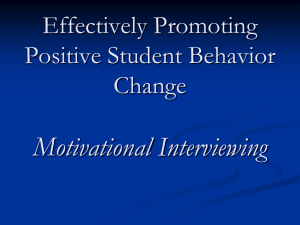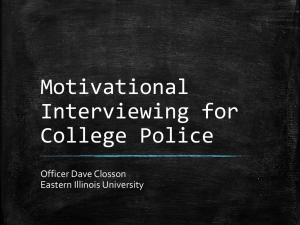Moyer and Miner HOs Motivational Interviewing
advertisement
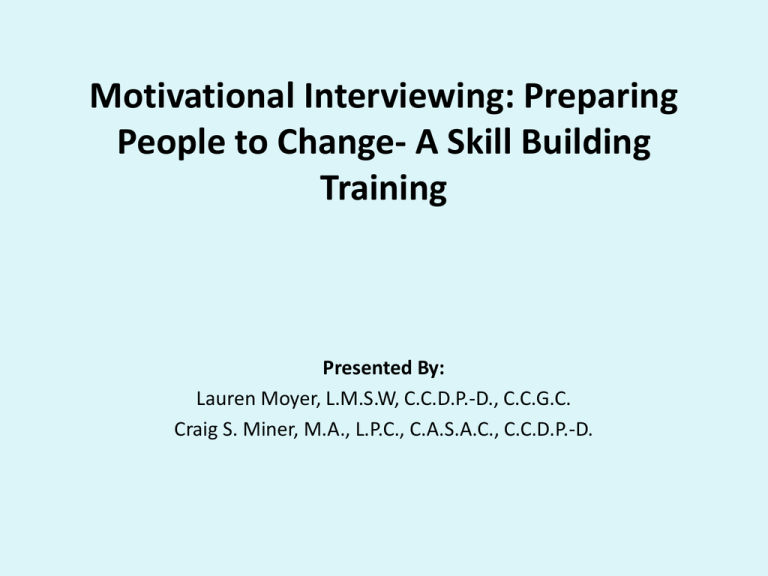
Motivational Interviewing: Preparing People to Change- A Skill Building Training Presented By: Lauren Moyer, L.M.S.W, C.C.D.P.-D., C.C.G.C. Craig S. Miner, M.A., L.P.C., C.A.S.A.C., C.C.D.P.-D. Learning Objectives • Understand Motivational Interviewing in the framework of stages of change • Implement the Motivational Interviewing Spirit, Principles and Strategies • Build basic skill application of Motivational Interviewing Integrated Treatment Defined • Integrated Treatment is how we organize (or reorganize) ourselves around a set of best practice treatment principles to improve services for individuals with co-occurring psychiatric and substance use disorders… • Our system of care… • Our programs… • Our services… Core Resource Substance Abuse and Mental Health Services Administration (SAMHSA) best practice for system change… • Comprehensive Continuous Integrated System of Care (CCISC) Model • Minkoff & Cline CCISC Principle • Dual diagnosis is an expectation… “Expectation not an exception”… – 50% of clients with severe mental illness have a lifetime substance use disorder, and 25 – 35% have an active substance abuse problem… – Approximately 60% of individuals with a substance use disorder have an identifiable psychiatric diagnosis… Why Integrated Treatment? • A high rate of co-occurrence, or comorbidity, between substance use disorders and mental illness… • Comorbidity affects the course and prognosis of both the individuals mental health and substance abuse issues… • Individuals experience poorer outcomes than those with only a mental health or substance abuse issue… • Higher service utilization and increased service costs… • Traditional practice of treating co-occurring disorders as separate conditions in a parallel fashion is largely ineffective… • We have identified integrated best and evidence-based practices that result in improved outcomes for these individuals… Motivational Interviewing is one of these practices… Stage-Sensitive Style Defined • Stage-Sensitive Style is when we organize (or reorganize) ourselves to utilize best and evidence-based interventions which align with the person’s stage of change/treatment or readiness for change… Why Stage of Change? • Provides a framework for understanding the process of behavior change and determining which interventions to use within each stage of change… • Views motivation as a state of ‘readiness’ to move through the stages of change… • Proposes a predictable pathway for behavior change… • Offers an alternative to other approaches that view people as in denial, resistant, uncooperative if they are not ready to accept change… STAGE of CHANGE STAGE of CHANGE Pre-Contemplation Pre-Contemplation Pre-Contemplation: Client is not yet considering change or is unwilling/unable to change… You may think I have a problem but I don’t so stop bugging me… You need to gain the clients trust so they know we are not going to hurt them… This way you can get to know their story and begin to talk with them inside their story… Contemplation STAGE of CHANGE Pre-Contemplation Contemplation Contemplation: Client acknowledges concerns and sees possibility for change but is ambivalent or uncertain… I’m not changing – in fact I don’t even have a problem but I am willing to talk to you about my life & what is going on… Consider if changing anything would make sense in my life and what I want my life to be about… This is where you talk with them (not at them)… Don’t jump too quickly into preparation/action… Contemplation; Preparation STAGE of CHANGE Pre-Contemplation Preparation Preparation: Client is committed to making a change but is still considering what to do… I think I might want to do something a little different, but I don’t know what and I have started and I need some help to get started… I have found the small thing that makes sense to work on to make my life better and I know a bit about how to start… Early Action Contemplation; Preparation Action STAGE of CHANGE Pre-Contemplation Action - Early Action Action: Client is actively taking steps to change but has not yet reached a stable state… Early Action: I’ve started to make some change, but don’t misunderstand me I don’t think I have to commit to everything everybody else thinks I do but this change is good, hard but good… Learn, try, and learn some more… Progress not perfection… Be careful to keep this slow… Don’t speed up just because you think since they want to change one thing we should add in others… Early Action Contemplation; Preparation Action Late Action STAGE of CHANGE Pre-Contemplation Action – Late Action Action: Client is actively taking steps to change but has not yet reached a stable state… Late Action: I’m really working on getting it together, I may not be very good at it but I’m figuring it out.. I’m coming to think that my goal is starting to sound a lot like others that have been down this path… The more I learn by doing, the more this is all connecting up for me… I see more and more that I have to do this if my life is going to be what I want it to be…. My job is to get the help I need and keep working, regardless of the ups and downs I am having… Early Action Contemplation; Preparation Action Late Action STAGE of CHANGE Maintenance Pre-Contemplation Maintenance Maintenance: Client has achieved initial goals such as abstinence and is now working to maintain gains… I’ve done a good thing for myself and I am stable and trying to stay that way… I have come to appreciate who I am and that I am who I am… I must do what I need to do to keep learning so I can maintain and meet all of life’s challenges so I can grow… Even though this is a problem that may continue to exist, I am not it and it is not me… I know that I am on the right path and I want to stay on it… Continue to focus on growth… Early Action Contemplation; Preparation Action Late Action STAGE of CHANGE Maintenance Pre-Contemplation Recurrence/Relapse Client has experienced a recurrence of symptoms and must now cope with consequences and decide what to do next Early Action Contemplation; Preparation Action Late Action STAGE of CHANGE Maintenance Pre-Contemplation Stage-Wise Interventions • Pre-Contemplation – Outreach, crisis intervention, practical support, listen, trusting relationship, assessment • Contemplation & Preparation – Motivational Interventions, Payoff Matrix, education, set goals, build awareness of problem, skills training, family support, peer support, • Action – Substance abuse counseling, CBT, medication treatments, skill building, family support, self help groups • Maintenance – Relapse prevention plan, continue skills building in active treatment, expand recovery to other areas of life, continue to improve quality of life Motivational Interviewing Defined • “Motivational Interviewing is a directive, client-centered counseling style for eliciting behavior change by helping clients explore and resolve ambivalence.” More recent definition… • “Motivational Interviewing is a collaborative, person-centered form of guiding to elicit and strengthen motivation for change.” Core Resources • Motivational Interviewing: Preparing People for Change • Miller & Rollnick • TIP#35: Enhancing Motivation for Change in Substance Abuse Treatment • SAMHSA • Integrated Treatment for Dual Disorders: A Guide to Effective Practice • Mueser, Noordsy, Drake, & Fox • • • • • Where to Begin… The Recovery Relationship Welcome Provide Empathy & Hope Applaud Empower Understand the Individual’s Story and SelfDefined “Happiness” • Find the Individual’s Strengths • Partner with the Individual for Recovery Planning • Stay Engaged No Matter What Why Motivational Interviewing? • 80 % of individuals with substance use disorders are in a precontemplation or contemplation stage of change… • Provides an alternative approach to the traditional ‘medical/disease model’ where the helping professional interacts in a non-collaborative sometimes confrontive style as the ‘expert’ who’s knowledge is the ‘cure’ with little regard for the clients level of motivation or readiness for change… • Since clients early in treatment are often not motivated it is a clinical task of the helping professional to help the person become motivated with appropriate counseling… What Is Motivation? “Motivation can be understood not as something that one has, but as something that one does. It involves recognizing a problem, searching for a way to change, and then beginning and sticking with that change strategy.” Miller & Rollnick State of mind, not a character flaw Multidimensional, dynamic and fluctuating Interactive and modifiable by clinician Counselor & Client Interpersonal Process • Differences in the magnitude of success of individual counselors exceed the differences between treatment approaches… • Research indicates that counselor empathy can be a significant determinant of client’s positive response to treatment… • Conversely, confrontational counseling has been associated with high dropout rates and relatively poor outcomes… • Counselor’s who believe their client will change will likely have that result… Conflict & Ambivalence • Conflict normally causes Ambivalence • Ambivalence normally causes Conflict • • • • Approach-Approach Conflict Avoidance-Avoidance Conflict Approach-Avoidance Conflict Double Approach-Avoidance Conflict Decisional Balance Pay Off Matrix Advantages of Using Substances Advantages of Not Using Substances Disadvantages of Using Substances Disadvantages of Not Using Substances Ambivalence • Common human experience and a stage in the normal process of change… • Getting stuck in ambivalence is also common… • Approach-Avoidance Conflicts can be particularly difficult to resolve on one’s own… • Resolving ambivalence can be a key to change, and, indeed, once ambivalence has been resolved, little else may be required for change to occur… Ambivalence Over Time in Treatment Level of ambivalence contemplation & preparation Ambivalence action precontemplation maintenance time --> Righting Reflex • Attempts to force resolution in a particular direction (as by direct persuasion or by increasing punishment for one action) can lead to a paradoxical response, even strengthening the very behavior they were intended to diminish… • Important to inhibit the righting reflex • Resistance may be a result of client-counselor relationship that lacks agreement, collaboration, empathy or client autonomy • Counsel in a directive, confrontational manner and resistance goes up Developing Discrepancy • Employ strategies that facilitate the client’s identification of discrepant elements of a particular behavior or situation… • Past versus Present • Values versus Behaviors • Behaviors versus Goals • When a behavior comes into conflict with a deeply held value, it is usually the behavior that changes… • The larger the discrepancy, the greater the importance of change… Change Talk • A guiding principle of MI is to have the client, rather than the counselor, voice the argument for change… • Change talk refers to client’s statements that indicate an inclination or reason for change… • As a person argues on behalf of one position, they become more committed to it… • The more a person talks about change in the course of a conversation, the more likely change is to occur… • Counsel in a reflective, supportive manner, and resistance goes down while change talk increases… Summing It Up! • People experience ambivalence… the conflicting thoughts and feelings about a particular behavior or change that holds advantages and disadvantages for them… • When a person experiences a discrepancy between how things are and how they ought to be, they tend to be motivated to reduce that discrepancy if it seems possible to do so… • Person has to argue for change… • Counselor collaboratively joins the person to guide them to develop discrepancy between their actual present and desired future in order to intensify, explore, and resolve their ambivalence while emphasizing their change talk and helping them to tip the decisional balance towards change What is Motivational Interviewing? Phases of Motivational Interviewing Phase 1 Goal: Build Intrinsic Motivation for Change Pre-Contemplation, Contemplation, & Preparation Stage of Change Enhance Importance [Willing] Enhance Confidence [Able] Phase 2 Goal: Strengthen Commitment to Change Plan [Ready] Preparation, Action, & Maintenance Stage of Change Prepare for Change (develop a plan) Take Action (implement the plan, enhance self-efficacy) Maintain Change over Time Spirit of Motivational Interviewing • Collaboration (Instead of Confrontation) Exploration Support rather than persuasion or argument Positive atmosphere that is conducive but not coercive for change • Evocation (Instead of Education) Not imparting things but rather eliciting ideas and drawing them out from the person Not instilling but drawing out intrinsic motivation • Autonomy (Instead of Authority) Client is responsible for change Change arises from within and is connected to the client’s own goals and values Principles of Motivational Interviewing Core Principles: • Express empathy… To understand the client’s world… • Acceptance facilitates change • Skillful reflective listening is fundamental • Ambivalence is normal Principles of Motivational Interviewing Core Principles: • Develop discrepancy… To help the client see their personal goals are inconsistent with their current behavior and thus to motivate the client to change the behavior… • A discrepancy between present behavior and important personal goals or values will motivate change • The client should present the argument for change Principles of Motivational Interviewing Core Principles: • Rolling with Resistance… To overcome the client’s resistance to behavior change by acknowledging and dealing with it but avoiding direct confrontation… • Avoid arguing for change • Resistance is not directly opposed • New perspectives are invited but not imposed • The client is the primary resource in finding answers and solutions • Resistance is a signal to respond differently Principles of Motivational Interviewing Core Principles: • Support self-efficacy… To foster hope in the client that they can achieve desired changes… • A person’s belief in the possibility of change is an important motivator • The client, not the counselor, is responsible for choosing and carrying out change • The counselor’s own belief in the person’s ability to change becomes a self-fulfilling prophecy Principles of Motivational Interviewing Additional Principle: • Establishing personal goals… To establish goals that are genuinely personal and meaningful for the client, in order to increase the client’s willingness to work toward them… • Talk with the client about their aspirations, desires, fantasies • Get to know what the client was like in the past, such as finding out their past, such as finding out about their preferred activities, admired people, personal ambitions • Do not discourage the client from expressing ambitious goals Phase 1: Building Motivation for Change Remember… Phase 1 involves building intrinsic motivation for change by resolving ambivalence…. Willing and Able? • Importance Ruler [Willing] • How important would you say it is for you to ______? On a scale of 0 to 10, where 0 is not at all important and 10 is extremely important, where would you say you are? • Confidence Ruler [Able] • How confident would you say you are, that if you decided to __________, you could do it? On the same scale from 0 to 10, where 0 is not at all confident and 10 is extremely confident, where would you say you are? Early Traps to Avoid • • • • • • Question-Answer Trap Taking Sides Trap Expert Trap Labeling Trap Premature Focus Trap Blaming Trap Effective Strategies - OARS • • • • Ask Open Questions Listen Reflectively Affirm Summarize Plus… • Elicit Change Talk • OARS directly supports the goal of encouraging client speech while the clinician is eliciting and shaping certain kinds of client speech… change talk… Open-Ended Questions??? • Atmosphere of acceptance and trust • Client should do most of the talking • Counselor is listening carefully and encouraging expression so the client can explore their own experience, including ambivalence • Avoid yes or no questions • Example: Tell me what brings you here today? Open-Ended Question Exercise • Make the following closed questions into open questions So you are here because you are concerned about your use of alcohol, correct? How many children do you have? Do you agree that it would be a good idea for you to go through detoxification? Do you like smoking marijuana? How has your drug use been this week compared to last: more, less or about the same? Do you think you use crystal meth too often? Reflective Listening • Reflection is particularly important after openended questions • The essence of a reflective listening response is that it makes a guess as to what the speaker means • Gives the counselor an opportunity to confirm, rather than assume, that you [counselor] knew what the person meant What is Reflective Listening? Model of Listening from Thomas Gordon What Words The Speaker Says What The Speaker Means The Words The Listener Hears What The Listener Thinks The Speaker Means Not Reflective Listening • • • • • • • • • • • Ordering, directing, commanding Warning/threatening Giving advice, making suggestions, providing solutions Persuading with logic, lecturing, preaching, telling what to do Disagreeing, judging, criticizing Agreeing, approving, praising Shaming, ridiculing, blaming Interpreting or analyzing Reassuring, sympathizing Questioning or probing Withdrawing , distracting, humoring, changing the subject Reflective Listening • A guess at what client means by what they just said • Is always in the form of a statement never a question • It can be simple or complex – Complex reflections add meaning or emphasis to what has just been said – Complex reflections moves the exploration process forward • It is collaborative/non-authoritarian; it is a guess not an interpretation • It is reinforced by client’s response • It is never critical, judgmental, confrontational • It can be directive (selective) but never directs by giving advice/suggestions without permission. “Selective” Reflective Listening • Reflective listening is not a passive process… It can be quite directive • Counselor determines what to reflect in order to emphasize or deemphasize certain aspects of what the person is saying • For example, change talk is preferentially reflected so that people hear their own statements of change at least twice Level of Reflection • Repeating: The first or closest to the surface level of reflection is simply repeating what someone has just said. • C: I really miss going out with my friends, I am more lonely now that when I started treatment. • T: You are more lonely now then when you started treatment • Rephrasing: The next level of reflection is to rephrase what a person has just said with a few word substitutions that may slightly change the emphasis. • C: I feel I have no control over my life, you are all telling me what to do • T: You feel like we are intruding into your life and you can no longer do what you want Level of Reflection • Paraphrasing: Major restatement. The listener infers the meaning in what was said and reflects this back in new words. This adds to and extends what was actually said, like continuing the paragraph, saying the next sentence rather than repeating the last one. C: Yeah, the court sent me here T: And that is the only reason you’re here. Level of Reflection • Reflection of Feeling: This is a special kind of paraphrase as it achieves the deepest level of reflection because you are not necessarily reflecting content, but the feeling or emotion underneath what the person is saying through feeling statements, metaphor etc. C: I am not sure that I want to work, it may be too much for me. T: Going to work in the community is different than working at Places, it sounds like you are feeling afraid that you will not be able to do the job. Level of Reflection • Simpler (repeating, rephrasing) reflections are used first, when meaning is less clear • Deeper reflections (complex) are ventured as understanding increases • Jumping too far beyond what was said can turn into interpretation Advantages of Responding with a Reflective Listening Statement • It is unlikely to evoke client resistance • It encourages clients to keep talking and exploring the topic • It communicates respect and caring and builds the therapeutic alliance • It clarifies for you exactly what the client means • It can be used to reinforce ideas expressed by the client Affirm • In MI, affirmations are genuine, direct statements of support during the counseling sessions that are usually directed at something specific and change oriented that the client has done • These statements demonstrate that the counselor understands and appreciates at least part of what the client is dealing with and is supportive of the client as a person • The point of affirmations is to notice and acknowledge client effort and strength. Affirm • Say something positive or complimentary • Can be in the form of appreciation, confidence or reinforcement • Comment on client’s strengths or efforts Appreciation: “You're a very resourceful person” “Thank you for coming today” Confidence: “You’ve succeeded through some difficult changes in the past” Reinforcement: “That’s a good idea” “Good for you” Benefits of Affirmations • Strengthens the working relationship • Enhances the attitude of selfresponsibility and empowerment • Reinforces effort and self-motivational statements • Supports client self-esteem and builds self-efficacy Summarizing • A form of reflective listening • Help structure a session so that neither client nor counselor gets too far away from important issues and can help you link what a client just said to something he offered earlier. • Summary statements can be used to link together and reinforce material that has been discussed. • Show that you have been listening carefully and prepare client to elaborate further. • Summaries can be used to just collect what has been said and then ask “what else” • Summaries can be used to link material offered earlier especially in clarifying ambivalence • Summaries can be transitional; either in wrapping up a session or moving from phase 1 to phase 2 Eliciting Change Talk • Although OARS skills are fundamental to motivational interviewing if we only used OARS it would be more difficult to resolve ambivalence for the client • Eliciting change talk is primary method for developing discrepancy • Remember the idea in motivational interviewing is to have the client give voice to the arguments for change and it is the counselor’s task to facilitate the client’s expression of such change talk Developing Discrepancy Goal: To create a significant (to the person) dissonance or discrepancy between the person’s behavior and important personal goals… The greater the discrepancy between personal goals and values the greater the perceived importance of change Four Types of Change Talk 1. Recognizing Disadvantages of the Status Quo Cognitive recognition there is a problem “I guess this is more serious than I thought” Affective expression of concern “I am really worried about what is happening to me” 2. Recognizing Advantages of Change “I would be able to see my family more often” 3. Expressing Intention to Change Talk about wanting to change “I think it is time for me to think about quitting” 4. Expressing Optimism About Change Encouraged/hopeful about ability to change “I think I could probably do it if I decided to” Strategies for Eliciting Change Talk Asking Evocative Questions Simply ask the person for change statements Open ended questions used to explore client’s perceptions and concerns “What are some of the down sides of your cocaine use?” Exploring the Pros and Cons Have client discuss both the positive and negative aspects of present behavior, the status quo Clarifies both sides of the ambivalence Use Decisional Balance Sheet (similar to Payoff Matrix) Strategies for Eliciting Change Talk • Importance Ruler How important is it for change______? On a scale of 0 to 10 where would you say you are? Why are you a ___? And not zero? What would it take to go from a ____? To a (higher number) Strategies for Eliciting Change Talk • Asking for Elaboration Have client elaborate on change talk before moving on Will elicit and reinforces further change talk and “In what ways? how much? Describe the last time this happened” • Imagining Extremes Ask client to describe the extremes of their concerns, to imagine the extreme consequences “What are your worst fears about what might happened if you don’t make a change?” “What do you believe would be the worst thing that might happen if you keep drinking the way you are right now?” • Looking Forward Help clients envision a changed future. Ask how it might be after a change “What would be the best results you can imagine if you make a change?” Strategies for Eliciting Change Talk • Looking Back Have person remember times before problem emerged, compare these with present situation For clients with SMI one can explore last period of work, sobriety, better functioning “Do you remember when things were going better for you? What has changed?” • Exploring Personal Goals and Values • Key strategy for clients with co-occurring disorders Developing Discrepancy Through Exploring Goals & Values Clients have valuable personal goals Awareness of consequences (impact on goals) is important and helps clients examine their behavior A discrepancy between present behavior and steps towards important goals will motivate change The client should present the argument for change Goal Exploration • Is a means to create discrepancy and begin to build self-efficacy • Talk with clients, establish personal, meaningful goals that the client wants. Get to know what the client was like in the past. Elicit thoughts about how things could be different Values Dreams Past preferred activities Admired people Don’t discourage ambitious goals Examples of Goals Finding a job Completing high school Finding a girlfriend Getting married Rekindling a relationship with an old friend Going fishing with one’s father Getting one’s own apartment Resuming parenting responsibilities Re-establishing relationships with siblings Handling one’s own money Buying a car Responding to Change Talk • Goal is to respond in ways that reinforce and increase change talk • Strategies for reinforcing & increasing change talk Elaborating Change Talk Respond with interest, ask for elaboration Reflecting Change Talk Clarifies the client’s meaning and encourages continual exploration Summarizing Change Talk Gather together the change statements. Selective. Client hears again their own change talk Affirming Change Talk Reinforce by commenting positively on it. “That sounds like a good idea” “I can see how that would concern you” Resistance • Resistance arises from the interpersonal interaction between counselor and client • Resistance is observable behavior that occurs during treatment • It signals dissonance within the counseling relationship • Your goal is to double back and understand the resistance/dissonance and address it Responding to Resistance • Remember it is how you respond to client resistance that makes the difference and that distinguishes motivational interviewing from other approaches… So roll with it Roll with Resistance • Opposing resistance generally reinforces it • Resistance, however, can be turned or reframed slightly to create a new momentum toward change • The interviewer does not directly oppose resistance, but rather rolls and flows with it • Reluctance and ambivalence are not opposed but are acknowledged to be natural and understandable • The interviewer does not impose new views or goals, but invites the client to consider new information and offers new perspectives Roll with Resistance • Do not feel obliged to answer a client’s objection or resistance • In MI, the counselor commonly turns a question or problem back to the person, and relies on the client’s personal resources to find solutions to his/her own issues • Rolling with resistance includes involving the person actively in the process of problem solving • Resistance is a signal for the interviewer to shift approach • How the interviewer responds will influence whether resistance increases or diminishes Recognizing Resistance Four categories of resistance behavior: 1. Arguing: the client contests the accuracy, expertise, or integrity of the counselor... Includes challenging, discounting, hostility 2. Interrupting: the client breaks in and interrupts the counselor in a defensive manner 3. Negating: the client expresses an unwillingness to recognize problems, cooperate, accept responsibility or take advice… Includes blaming, disagreeing, excusing, claiming impunity, minimizing, pessimism, reluctance, unwillingness to change 4. Ignoring: the client shows evidence of not following or ignoring the counselor Lower Resistance It is desirable to decrease client resistance because: Resistance early in treatment is associated with drop-out Resistance predicted a lack of change in behavior Decreased resistance is associated with long term change Always Avoid Arguments • Arguments are counterproductive • Defending arguments breeds defensiveness • Labeling is unnecessary - Identify behavior, don’t label or diagnose • drinking (not alcoholism) • isolating (not paranoia) • talking to voices (not schizophrenia) Strategies for Handling Resistance • Simple Reflection – acknowledge client’s perception, avoids argument, joins with client, encourages further exploration • Amplified Reflection – exaggerated reflection to encourage some retreat, explores other side of ambivalence • Double-sided Reflection – acknowledges both sides of the ambivalence based on client’s perceptions • Shifting Focus – shift attention away from roadblock and redirect attention to workable issue Strategies for Handling Resistance • Reframing – acknowledges validity of client observations but offers new meaning or interpretation (useful with resigned client) • Agreement with a Twist – initial agreement but slight twist, reflection followed by reframe • Emphasizing Personal Choice & Control – reassure client about self-determination, (useful with rebellious client or one who perceives freedom as threatened) • Coming Along Side/Therapeutic Paradox – Siding with the negative -defends the counter argument, should diffuse no change argument, illicit change talk from client Early Stages: Resistance and the “Four R’s” • Reluctance Lacks the knowledge, energy or insight to change • Treatment options: Provide feedback in an empathic manner Avoid arguments Resignation Appears overwhelmed with problem, may have given up Treatment options for resignation: Instill hope/confidence in their ability to change Reframe Help meet small goals, remind of past success Explore barriers to change Early Stages: Resistance and the “Four R’s” • Rationalization Afraid to risk, unable to see their behavior as a problem, focused on others Treatment options: Support, small steps to success, remind of past success Revisit goals, decisional balance • Rebelliousness Identity is intertwined with problem behavior, need to feel in control, reacting to external pressure Treatment options: Provide choices Emphasize personal choice and freedom Use paradoxical strategies The Role of Confidence • Change is mediated by the importance and the confidence to accomplish something Strategies for Enhancing Confidence • Ask Evocative Questions: Confidence talk is one type of change talk. Ask open-ended questions. “How might you go about making this change?” “What gives you the confidence that you can do this?” • Confidence Ruler: “How confident are you on a scale of 010 that you can….” ‘Why are you a ___rather than a 0?” The answer will be confidence talk • Review Past Successes: Look for changes client made on own. Look for skills, strengths that can be generalized to present situation. Explore. “Tell me how you did that” Strategies for Enhancing Confidence • Explore Personal Strengths & Supports: “What is there about you, what strong points do you have that could succeed in making this change?” Explore what sources of support are available • Brainstorm: Freely generate as many ideas for accomplishing change as you can develop… no discussion or criticism until list completed… then prioritize • Giving Advice and Information: If asked by clients offer advice within MI context – final choice is client’s. Strategies for Enhancing Confidence • Reframing: Person often bogs down in attributions of failure… reframe ‘failure’ in way that encourages client to keep trying • Hypothetical Change: Use when client is struggling with practicalities… “Suppose you did succeed and are looking back on it now. What is it most likely that worked? How did it happen?” Phase II: Strengthening Commitment to Change Remember… • Phase 2 involves strengthening commitment to change and developing a plan to accomplish it… Signs of Readiness for Change • • • • • • • Decreased Resistance Decreased questions about the problem Resolve Self-motivational statements Increased questions about change Envisioning Experimenting Watch out for Underestimating ambivalence Over-prescribing an action plan Not providing sufficient direction when asked Negotiating a Change Plan • Transitional to Phase 2 • Recapitulation (transitional summary) • Ask Key question (open ended): “What would you like to do about this?” • Giving Advice and Information • Negotiating a Plan • Elicit client’s ideas • Set Goals (client goals) “What is it you would like to change?” “Let’s take things one step at a time. What do you think is the first step?” • Consider change options – what actions/supports/skills will be needed • Arrive at the plan and elicit commitment Adapting Motivational Interviewing for Clients with Co-Occurring Disorders • Different targets for change: ambivalence about treatment engagement, medication… • Increase affirmations • Avoid reflections of hopelessness • Reduce reflections on disturbing thoughts and life experiences • Frequent, short reflections most effective • Frequent summaries • Simple verbal and visual materials: make explicit links between psychosis, substance abuse, lifestyle, consequences… • Pacing • Clients must have some psychiatric stability to benefit from MI’s approach Pre-Contemplation • Establish rapport, utilize empathy & reflective listening, ask permission and build trust • Facilitate discussion to assist client to identify risks and consequences associated with identified behavior (i.e. raise doubts or concerns in the client about substance-using patterns) • Facilitate discussion to assist client to identify benefits of change • Listen for all levels of change talk • Express concern and keep the door open Contemplation • Normalize & negotiate ambivalence • Weigh pros and cons • Help the client “tip the decisional balance scale” toward change • Elicit change talk of intent and commitment from the client • Elicit ideas regarding the client’s perceived self-efficacy and expectations regarding treatment • Summarize change talk statements Preparation • • • • • • • • • • • Clarify the client’s own goals and strategies for change Offer a menu of options for change or treatment With permission, offer expertise and advice Negotiate a collaborative change- or treatment- plan and behavior contract Consider and lower barriers to change Help the client enlist social support Explore treatment expectancies and the client’s role Elicit from the client what has worked in the past either for him or others whom he knows Assist the client to negotiate finances, child care, work, transportation, or other potential barriers Have client publically announce plans to change Build self-efficacy for change Action • Engage the client in treatment and reinforce the importance of remaining in recovery • Support a realistic view of change through small steps • Acknowledge difficulties for the client in early stages of change reinforcing small gains • Help the client identify high-risk situations through a functional analysis and develop appropriate coping strategies to overcome these • Assist the client in finding new reinforcers of positive change • Help the client assess whether they have a strong family and social support • Maintain regular contact and provide sufficient direction Maintenance • Help the client identify and sample drug-free sources of pleasure (ie new reinforcers) • Support lifestyle changes • Affirm the client’s resolve and self-efficacy • Help the client practice and use new coping strategies to avoid a return to use • Maintain supportive contact • Develop a “fire escape” plan if the client resumes substance use • Review long term goals with the client Recurrence • Assure client that slips and relapses are normal and can be overcome • Reframe relapse as a learning experience helping the client to avoid becoming discouraged and demoralized • Help the client reenter the change cycle and commend any willingness to reconsider positive change • Help client renew determination and confidence in order to resume change efforts • Assist the client in finding alternative coping strategies • Maintain supportive contact Matching Stages of Change, SATS and Types of Interventions Stage of Change SATS Interventions IDDT methods Precontemplation Preengagement & engagement Outreach, practical health, crisis intervention, relationship building, assessment CRS; SATS, Longitudinal Assessment; Contextual Assessment; Payoff Matrix/Functional Analysis; Motivational Interviewing Contemplation Early persuasion & & preparation Late persuasion Education, goal setting, increase awareness of problems practical skills training, family support, peer support Motivational interviewing (expressing empathy,developing discrepancy, eliciting change talk, rolling with resistance, supporting selfefficacy) Action Early active treatment & late active treatment Substance abuse counseling, medications treatment, skills training, self-help, groups, family therapy Functional analysis, skills training Maintenance Relapse prevention & remission Relapse prevention plan, continuing skill training, expanding recovery to other areas Continuation of functional analysis, skills training, specific relapse prevention plans
